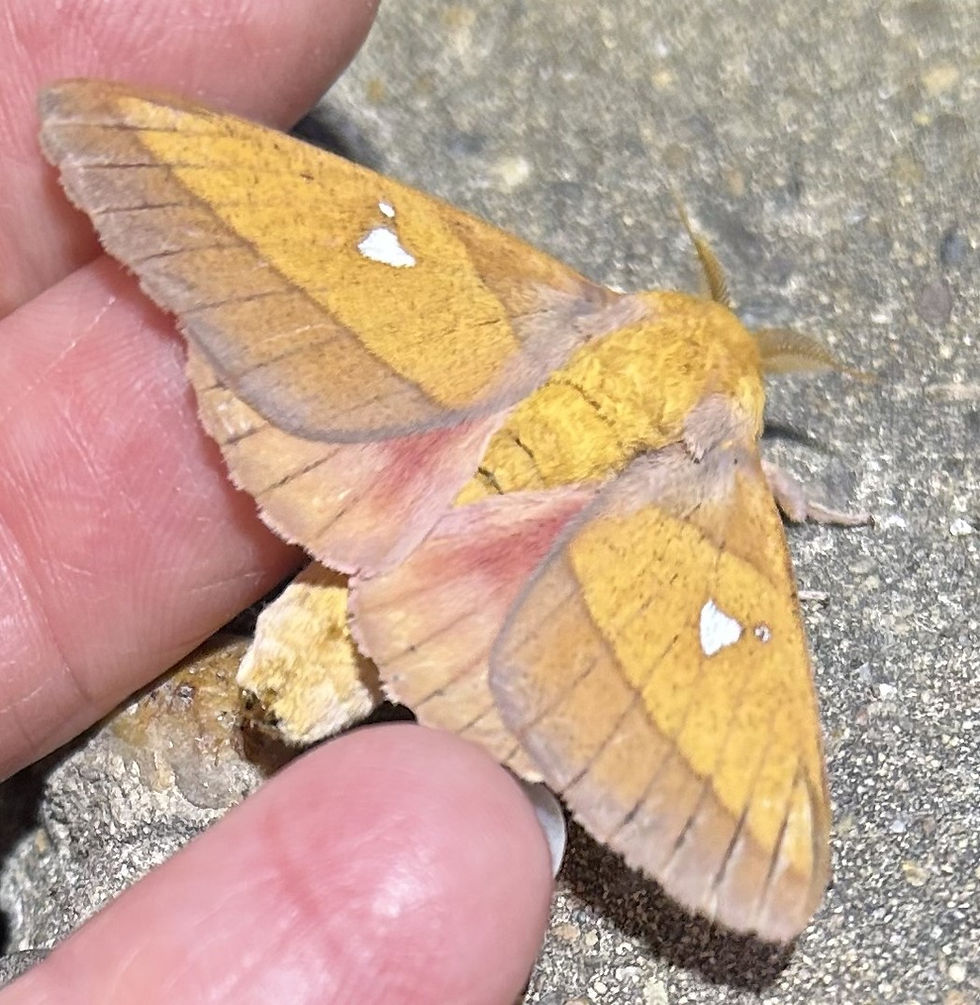Anita’s Blog – Moth Caterpillar Menus
- jjvanm
- Jul 15, 2024
- 3 min read

You may be feeding moth caterpillars and not even know it. And that’s a good thing! May, June and July have been fun months with the moth sheet and black light set up.
It’s not too late to set something up in your own yard for a summer project.
International Moth Week is July 20 – 27. On Saturday, July 20, beginning at dusk until midnight, Quinta Mazatlán in McAllen, kicks off Moth Week. I’ll be volunteering at one of the moth stations. Don’t miss out. This is an interesting and easy opportunity to help out as a volunteer or wander through the stations for a bit of advanced training time.
A lot of sphinx moths have visited my moth sheet recently. My sheet is propped up against a palm tree. Moths come to the black lights, hang around both sides of the moth sheet, on the trunk of the palm and in the grass. I’m also seeing moths that haven’t shown up for a couple of years.

I was particularly excited to see a rustic sphinx. The only other one I’ve observed was last June. I looked up what their caterpillars eat; turns out they use many host plants in several plant families, some native, some not. Checking off the plants in my yard against the list of plants was like winning a scavenger hunt.

If you have any of the following plants, you may be catering to rustic sphinx moths.
Native plants:
Common sunflower, Helianthus annuus; anacua, Ethretia anacua; heliotrope, heliotropium; American beautyberry, Callicarpa americana; lantana (West Indian), Lantana camara (some may quibble native status, it’s only been in the Valley for a hundred years); ash, Genus Fraxinus; and bushy lippie, Lippia alba, a flowering plant in the verbena family native to southern Texas, Mexico, the Caribbean, Central America and South America.

Non-native plants:
Cape honeysuckle, Tecoma capensis, crape myrtle, Lagerstroemia indica, jasmine, Jasminum, white fringetree, Chionanthus virginicus, privet, Ligustrum; basil, gardenia and Bignonia species, in the Bignoniaceae family, such as Jacaranda and trumpet vine.
The rustic sphinx moths are important pollinators and visit just about anything that blooms at night, (including bougainvillea, according to insectidentification.org). Sphinx moths can be attracted to black light/moth sheet set ups.
Another recent visiting moth caused me more excitement. Coffee-loving Pyrausta moth, Pyrausta tyralis; larval host: purplestem beggarsticks, Bidens connata.

A few of the ubiquitous visitors are:
Toxonprucha excavate; larval host plant is acacia, specifically, catclaw, Acacia greggii; possibly Wright’s catclaw acacia, Senegalia wrightii.
Isogona scindens leaves of sugar hackberry
Hawaiian Beet Webworm Moth, beets, chard, spinach and various species such as Amaranthus and Chenopodium.
Spotted Beet Webworm Moth, beets, chard, potatoes, amaranth and various greenhouse plants; the moth is also found in other parts of the world, BugGuide.net
Signate looper moth; larval host is mesquite
Indomitable graphic moth, Southern U.S., mostly; larval food is Mesquite.
Below, Toxonprucha excavat, Isogona scindens, Hawaiian and spotted beet webworm moth, signate looper and indomitable graphic moth. (Photos by Anita Westervelt)
Less frequent but fun visitors:
Eggplant leafroller moth; larval food are plants in the tomato (Solanaceae) family, such as eggplant, ground-cherry, pepper (Capsicum spp.) and garden tomato.
Interrupted lineodes moth. The interrupted most likely refers to the ribbon like markings in the middle that are broken up; BugGuide.net. Larval host plants are Solanaceae family plants, such as potato and tomato.
Chickweed geometer moth, chickweed, Stellaria spp., smartweed/knotweed, Polygonum spp., clover and other low plants. A plant identified as smartweed has grown around the edges of our resaca.
Below: Eggplant leafroller, interrupted lineodes, chickweed geometer moth. (Photos by Anita Westervelt).

The beautiful Syssphinx blanchardi uses Texas Ebony as a larval host.


Tamaulipan lichen moth, BugGuide.net notes that larvae have been collected from Psychia lichens on Texas Ebony

A new to my yard this week is Hübner’s Olive, Sphacelodes vulneraria. I was not successful in finding possible host plants even from my favorite go-to site, BugGuide.net. Only 10 observations from the Valley of this attractive moth are shown in the iNaturalist.org database. Joseph listed one in December 2021 and in July and November of 2022. An observation of the moth was recorded at Santa Ana National Wildlife Refuge in 2016 and at Sabal Palm Sanctuary, in Brownsville, during a moth light set up in May 2021.
The one visiting my set up in San Benito is a bit rough, but healthy nonetheless.


For details for setting up your own yard to attract moths, how to participate as a citizen scientist and for more information about mothing and national moth week, check out this link: https://nationalmothweek.org/



















תגובות